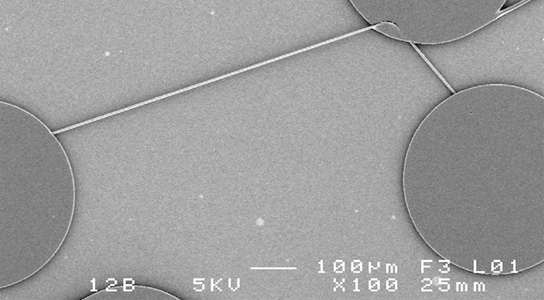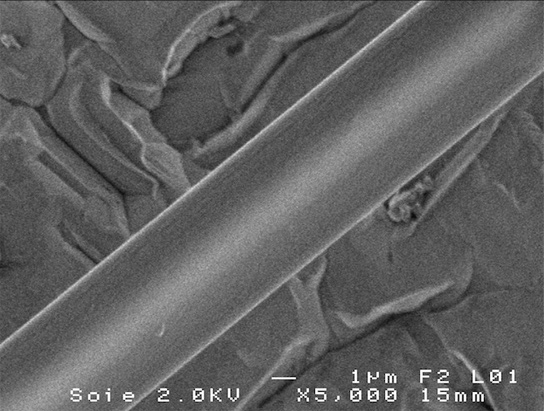
A silk fiber integrated into a photonic chip, connecting three disks that can hold light. Light is injected into one of the disks and propagates along the silk to the other two. Credit: Image courtesy of Nolwenn Huby
Silk is used by some insects and spiders to spin webs and cocoons, and now researchers have discovered a way to harness this supermaterial into electronic microchips. The silk is stronger than steel, tougher than Kevlar, yet incredibly malleable and flexible. However, that’s not all it can do.
Scientists will present their findings at this year’s Frontiers in Optics conference, happening from October 14 to 18, in Rochester, New York. Light can travel through a silk strand as easily as it travels through a fiber optic cable, states Nolwenn Huby, optical physicist at the Institut de Physique de Rennes, in France.

Scanning electron microscope view of a silk fiber. Credit: Nolwenn Huby
Huby and her team of scientists were able to transmit laser light down a strand of silk on an integrated circuit chip. The silk worked very much like glass optic fiber cables, suggesting that it could carry information for electronic devices, though it had about four orders of magnitude more loss than glass. With coating and further development, the silk could have better transmission capabilities.
Such silk fibers could carry light into places inside the human body for internal imaging, since spider silk is very thin, about 5 microns in diameter, ten times thinner than a human hair. Surgeons could use these to perform diagnostics with very small openings.
This material could be implanted as well, since the body has no adverse reaction to it. Silkworm silk shares many of the same properties as spider silk, but can be manufactured at an industrial scale since silkworms can be grown close together and produce lots of it. However, spiders need more space, and can be cannibalistic to other spiders, and produce less silk.
By using the silk from textiles and boiling it in water to extract the silky proteins, biomedical engineer Fiorenzo Omenetto is able to use this mixture to produce a sort of plastic that is 100 percent natural. Since silk is fully biodegradable, electronic silk technology could become widespread. By doping materials with silk, Omenetto’s team has already created a device that can shoot a blue laser beam. The gadget’s components are fully compostable and also use less power than equivalent acrylic laser shooters.









Be the first to comment on "Spider Silk Could Be Used To Manufacture Biodegradable Microchips"